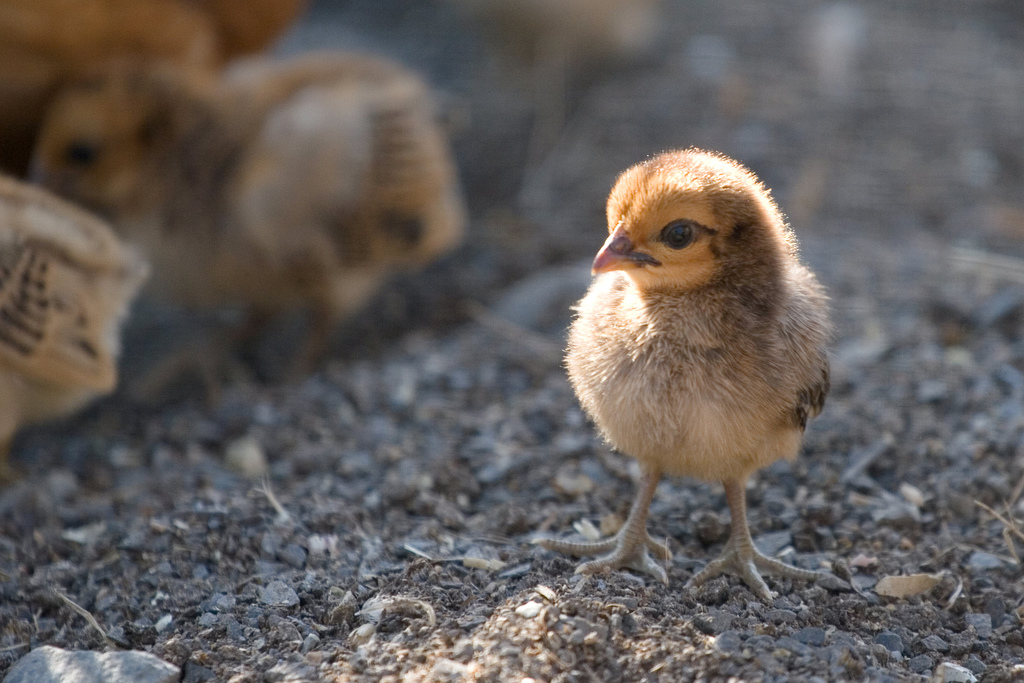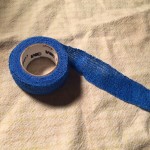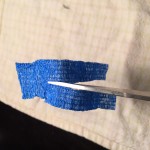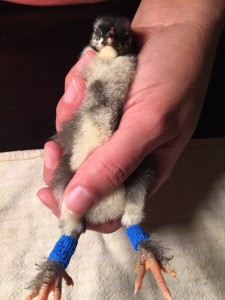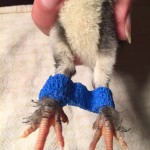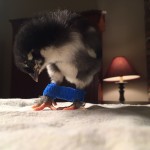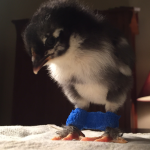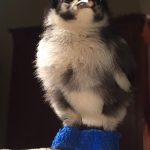Springtime brings spring chicks to many of our homes. Spring chicks occasionally can become injured and ill and require extra attention and care on the part of the owner. One common baby chick ailment is called “Splay Leg.”
Splay Leg (also commonly called “Spraddle Leg”) is a condition that causes young chicks to have one or both of their legs slip to the side of their bodies twisted out from the hip, making it impossible for the bird to walk or even stand. Splay Leg is often caused by the use of slick surfaced materials (e.g. newspaper) for brooder bedding. The condition may also be caused by vitamin deficiency or incubator temperatures being too high or fluctuating.
Splay Leg is usually reversible if caught early and treated immediately. If left unaddressed, the splay-legged chick will be unable to reach food or drink on its own. Ultimately, the untreated bird would be permanently lame and have to be culled.
Chicks suffering from Splay Leg should have their shanks hobbled together to allow the bird’s legs to correct themselves. Though various household items can be used as a hobble (e.g. rubber band threaded through a short piece of drinking straw, bandaids, string, etc.) the preferred tool for this purpose is a self-adhesive medical wrap. Medical wrap is fairly cheap to purchase and widely available. I personally like 3M’s Vetrap and keep a stock of it in my chicken medkit (e.g. 3M Vetrap Bandaging Tape). Using a simple binding material, the splay legs are hobbled (tied) together so that the bird can stabilize itself enough to stand and walk. After a few days, if the treatment is effective, the chick’s legs should be strong enough to remove the binding.
If you suspect a vitamin deficiency, you can add a supplement such a Nutri-Drench (POULTRY NUTRI-DRENCH QT – 1 Quart) to the splay-legged chick’s water. Be sure to closely monitor any hobbled chick to ensure that it is not being trampled by the other chicks. You will also want to ensure that the hobbled chick is able to access the food and water easily.
Chicks suffering from Splay Leg if properly and promptly treated when the condition is first noticed, can completely recover from this ailment and enjoy normal, active lives when fully grown.
TREATING SPLAY LEGS STEP-BY-STEP:
Step One
Use a self-adhesive medical wrap to create the hobble for the splay-legged chick. I have a one inch wide roll of Vetrap brand medical wrap. Despite being only an inch wide, I found it necessary to cut the tape in half (lengthwise) to be a proper width for the chick’s leg. You are only wrapping the chick’s shanks below their hock joints (i.e. knees).
- Self-adhesive medical wrap
- Trim to properly fit chick’s legs
Step Two
Cut two short pieces of the self-adhesive medical wrap (“Vetrap”) into one inch pieces. Then used these short pieces as “pegs” wrapped around the injured chick’s shanks. These two pegs provide a better anchor for the length of Vetrap which will serve as the actual hobble. Be sure not to wrap these peg pieces of Vetrap too tightly around the bird’s shanks – you don’t want to cut off circulation to the bird’s feet.
Step Three
Next cut approximately six inches of the proper width Vetrap to be used as the actual hobble. Secure this segment of Vetrap to each of the pegs on the affected chick’s shanks. The hobble should be about an inch to one and a quarter inches wide between the bird’s two legs. Hobbling the splayed legs together in such fashion allows the injured chicken to stabilize itself enough to stand and walk. You should gradually narrow the gap of Vetrap between the two legs a bit (as the chick’s splay legs improve) so that the bird’s legs are finally back in a normal position.
Don’t be alarmed if your chick struggles at first to get its footing with the hobble. The chick will learn to use the hobble to stand and walk. Also, expect that your chick is going to initial hate the hobble and try to pull it off. Don’t worry the chick will eventually grow used it.
- Hobble 1 – 1 1/4 inches wide
- Chick uncertain of hobble
- Hobble helps chick stabilize
- Hobble will allow chick to stand & walk
RESOURCES:
- 2nd Chance – Correcting Spraddle/Splay Leg in Baby Birds ARTICLE
- Chicken-Chick – Spraddle Leg & Curled Toes – Causes and Treatments ARTICLE
- My Pet Chicken – Spraddle Leg Overview ARTICLE
- Poultry Help – Spraddle Leg (step-by-step pictures) ARTICLE
SUPPORT THE URBAN CHICKEN PODCAST:
- Support the Urban Chicken Podcast by shopping Amazon starting here: Amazon
- If Amazon is not your thing – you could also support the show HERE

